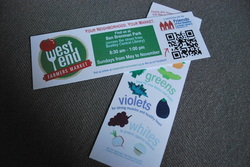 Dramatic lighting! Our 2012 season is over but thanks to our partnership with the Friends of the Beatley Central Library, the fun will go on into the winter! If you've stopped by the Friends' booth any of the past Sundays, you might have picked up this guy, designed especially to keep two very important activities together- eating and reading. If you didn't, download a PDF here! We designed this handy bookmark for many purposes. First, to connect us to our geographical location. We are right across Duke Street from our city's biggest library, and one that sees so much activity. Thousands of people use the Route 236 corridor EVERY DAY to access the highway and get to their schools, jobs, and other places of business. Perpendicular to that is also the Holmes Run Trail, which believe it or not, will get you to Eisenhower Avenue much faster walking than driving. There are at least ten residential towers and apartment complexes which to which it is easily accessible, not to mention all of the area between Seminary Hill and Alexandria West. The Library and the Market are in the perfect location to serve a huge portion of our fellow Alexandrians. Secondly, we believe that eating well doesn't require a fat wallet or a nutritionist. When people are stranded at sea, they begin to crave the things that they need and will skip a fishes' flesh for its liver. Humans instinctively know what's good for them. And you know when you're skimming through Saveur the things that make you drool are usually the most colorful. Haven't you ever been infatuated with a gorgeous Cobb salad? Isn't pico de gallo like the vegetable sprinkles for savory foods? Also, consider the learning opportunities for young kids. Use the bookmark to start teaching colors, or if you're working with someone a little older introduce color theory! Take it to the grocery as a scavenger hunt list. Make spaghetti but then give it sidekick! Maybe something green for a complementary color, or perhaps orange and yellow carrots for a warm color triad. This was made with a focus towards kids but clever parents can always find multiple lessons to teach from one thing. Finally, this is a bookmark. Save the page with tonight's dinner recipe with it. Tuck it in your current novel. Use it at the library while browsing books to mark where you pulled something from so you can return it to the right place. You know what to do. Hey folks! It's been a while since our last blog so we want to start off on a far more playful note than food borne illness. Actually, this was brought on by a recent trip to a big box retailer and a light background in sociology. Here at WEFM we know that food is a strong binding material for families- we see evidence of that every Sunday. Understandably so, playing house and, in particular, kitchen, is something which children do in all cultures. Stroll down the right aisle at your local toy store and you'll find miniature versions of your kitchen appliances, utensils and even produce molded from colorful plastic. But then take a closer look. 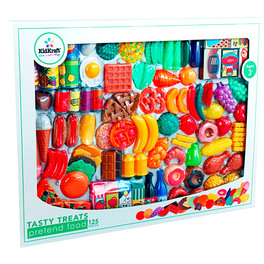 Maybe rename to "Dorm Life Food Set"? Eye catching, no real-life brands being subtly advertised to kids, a general assortment of fruits and veggies. Put it in the cart, right? Well, first examine the 'health food' to 'junk food' ratio. Seems like a lot of carry out, sugary snacks and desserts for a kid's toy. At least 14 of the 125 pieces are some manner of fried potato product. They're hard to tell in one glance because there are over a hundred little pieces to look at AND all the snacks are hidden close to the border. Still, this is not bad. Once I saw a set have the audacity to print on a mini-cereal box that it had artificial colors and flavors! Probably not the right message we want to give our little ones. 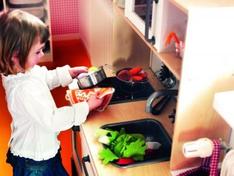 The mini-chef, playing Thanksgiving IKEA catalogs paint such a lovely picture of this game, complete with wee stainless steel spatulas and sauciers. Their sets, while pricey, are made of soft fabrics which can be washed after someone gets a little too into pretending to eat grilled salmon. Similarly, Melissa and Doug toys feature more fresh foods in great sets which can be applied to learn direction following, patterns and simple fractions. Also pricey, I would consider them like a nice wooden block set- something you'd be willing to keep for grandchildren. Or do it the old fashioned (and probably cheapest) way. Include your kids in the kitchen. They're more likely to eat whatever they've had a hand in... yes, even the stereotypically dreaded veggies.
Start with something simple like boxed mac 'n' cheese (Annie's is my favorite) but jazz it up! This is one of the easiest things to hack because cheese is so versatile. Before the pasta is fully cooked, toss in your mix-ins so they can heat up. Frozen veggies are easy for toddlers to scoop but a more dextrous child might like slicing up a hot dog with a butter knife (and adult supervision of course). Level up to pizza which can result in funny faced pies or the epic RAINBOW PIZZA. Before you know it your kids will be informed eaters and your kitchen will be a total mess. But you know what? That's probably worth it. 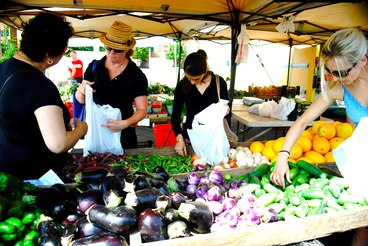 They say that first you eat with your eyes. Food can look wonderful but in the wrong hands, it could be a less than pleasant experience. Even then, in the hands of a professional, lackluster ingredients can't perform the same way that it's gourmet counterparts could. Still, this is only referring to the physical qualities of food, nutritional (and monetary) value is a whole other battle to be waged in the grocery. Yes, ladies and gentlemen. Shopping is a crucial part of food prep, and not just because you need ingredients to cook. Food should not only taste good, it also needs to be good for you. Smart consumerism is often taken to mean getting the most bang for your buck, but as Kerrie Martin, a certified Holistic Health Coach, and Penny Capps, a certified Massage Therapist and Personal Trainer, want us all to know that when it comes to your health quality is far more important than quantity. As a part of their discussion series "Making Food Choices Count", the duo held a casual field trip at our very own market. The group was eager to explore, shop and learn more about the things offered by farmer's markets, as well as the buzzwords attached to them. So, armed with reusable grocery bags and a ton of questions, they got hands-on with their food.  Sensationalist reporting may have scared you into believing that the sun is nothing but skin cancer waiting to strike you and the only way to prevent it is using SPF 100 (which, if you read this article, is really just kind of overkill). In reality, the sun's UV rays are the main producer of Vitamin D, a fat-soluble vitamin which isn't overabundant in nature except in foods high in Omega 3s and those fortified with it such as milk, cereal and good ol' OJ. Vitamin D is largely responsible for the proper mineralization of bone but also promotes the absorption of calcium, also a big contributor to the skeletal system. In the 19th century, studies were performed on patients with rickets and found that doses of cod liver oil, the best edible source of Vitamin D, were able to reverse the effects of the disease and in 1930 milk began to be fortified with it. With that, rickets, which was known for its telltale bone deformation, became as irrelevant to the modern world as scurvy. Whenever cases are reported today it is usually in people who spend a majority of their day indoors (homebound individuals, office workers, video gamers), and those with darker skin as the higher levels of melanin block some absorption of the sun's rays. A recent study published by Kaiser Permanente has also shown that women over 65 who had insufficient levels of Vitamin D tended to gain more weight than those who kept their Vitamin D at adequate levels as they aged.
Now don't get us wrong; we are in no way promoting gallivanting about in the sun all day- you don't need much exposure to get your fill and besides, sunburns and melanoma are serious reasons to refrain from such activities- nor are we defaming the name of sunscreen (in fact, sunscreen is the only "beauty" product which does prevent premature aging and it should be a part of everyone's daily toilette). But you remember how overuse of hand sanitizer bred super resilient bacteria, right? If the infamous "they" are saying something, it's probably as fact based as a rumor. Do your research too. Don't forget "everything in moderation", protect yourself and especially kids who are more susceptible to sun damage, and absolutely do enjoy your time outdoors this summer. June is National Dairy Month! Started in 1937 to counterbalance a surplus of milk, the holiday came to be observed by visiting local dairy farms, sharing favorite recipes and, of course, consuming lots of dairy products! Whether you prefer it as yogurt, ice cream or a classic cheese you're guaranteed to be doing wonders for your own health. And if you're trying to get ready for bikini season, milk contains nine essential nutrients which may help to better manage your weight and is also an excellent source of protein to follow a good workout. If now you're picturing a delicious grilled cheese or a tart berry parfait, keep reading. In its basest description, the West End Farmer's Market is just that- a market, a commercial center. However, we know that produce and money are not the only things exchanged here. Our vendors are worlds in themselves; travelers, backyard farmers, musicians, artists, parents, all of whom have more to offer than baked goods and handmade jewelry. So, it’s time we were all properly introduced. How Does a Farmers Market Affect the Community?
Tomorrow the Kojo Nambe radio show on WAMU will interview Sharon Gruber of Bread for the City. Bread for the City is a DC based food bank with cutting edge ideas on food and nutrition for low income recipients. They “Glean” fresh food from farmers and farmers markets to distribute as a healthy alternative to the processed foods most food banks rely on. Their website states “Bread for the City rescues tens of thousands of pounds of fresh, free surplus produce. Gleaning is an ancient practice of salvaging food that would otherwise go to waste in a food system.” They glean from farmers, farmers markets and trees in the DC area. It is a novel and creative method of procuring food for distribution to low income families. (1) Since Bread for the City provides a range of services including health care, it was important to them to support their health care initiative by providing fresh healthy foods for their customer base. Statistically it can be difficult to identify how the distribution of fresh food affects the habits of a community. Fortunately, in January 2008, The American Journal of Public Health published an article by four doctors who completed an in-depth, statistical analysis of the long term practices of low-income women who received assistance for the purchase of fresh local fruits and vegetables. This was a two month study conducted in Los Angeles, using scientific methodology which documented reactions of a control group to economic subsidies for fresh fruits and vegetables. These doctors wanted to know if access to fresh foods at a good price could change eating habits – and it did! Prior to this study, there were few quantitative studies on the effect on daily habits access to fresh foods might create. Kaiser Permanent did a small survey of patrons at their worksite farmers markets and discovered that nearly 3 of 4 shoppers reported that they consumed at least a few more fruits and veggies because of the market and more than half reported consuming an increased variety of fruits and veggies.(2) According to the American Journal for Public Health article, people with low incomes are at risk for poor dietary quality and for low consumption of fruits and vegetables. There are many factors that contribute, the chief among them being the lack of green grocers, supermarkets or farmers markets in low income neighborhoods, as well as the cost of fresh foods and veggies compared to the low cost of high sugar, high carbohydrate foods like potatoes, pasta, and rice. The doctors conducting the study provided two things to promote the choice of fresh vegetables and fruits: 1. economic subsidies for fresh fruits and veggies in the form of SNAP coupons, and 2. they made sure there was a farmers market and/or grocery store within walking distance of the SNAP offices. When you get into the middle of the article there are enough equations, percentages and statistics to give you a headache, so let me synthesize. Access to an economic subsidy for fresh fruits and veggies, as well as a site to purchase them in, resulted in a large increase in consumption of fruits and vegetables during the study and afterwards as well. “Farmers Market Participants showed an increase of 1.4 servings…” (complicated math – let’s just say it means people were eating fresh food at nearly every meal), while the “supermarket participants showed an increase of 0.8 servings.” “Participants redeemed more than 90% of the coupons and purchased a wide variety of fresh fruits and vegetables” Clearly people who frequented farmers markets were more likely to eat more fruits and veggies. This is probably because farmers markets are more fun than grocery stores. We don’t need a complicated scientific study to prove it, however this study states “farmers’ market participants thought produce at their site was fresher and of higher quality than at the supermarket”. Participants who purchased their produce at the farmers’ market also mentioned enjoying the pleasant “community experience” of meeting friends while shopping and interacting directly with growers. (3) Presently Bread for the City gleans at our market. We have a great relationship and love to see the truck drive up every week to haul off the goods. We support their efforts to promote healthy eating wholeheartedly. Our own efforts at promoting healthy eating are diverse: We have a wide range of foods at our market; we have had a Yoga class at the market and may offer more, we give away recipes, our operating non-profit Eden Good dedicated the summer to demonstrating how to can the fresh produce shown at our market, the Alexandria biking initiative has had a table at our market multiple Sundays, we will watch customers bikes for them if they bike to the market. Additionally, we are looking into adding the SNAP program, coupons for low income residents, to our market next season. If anyone reading this would like to assist with that research and planning, please contact us at [email protected]. Please listen to the Kojo Nambe Show this Wednesday at 1PM to hear Sharon Gruber, Bread for the City’s nutritionist, talk about their work. This Sunday - come and say hi and tell us your stories on how the market has affected your eating habits. I will add them to our blog. See you at the market! (1) Bread for the City Website. www.breadforthecity.org (2) Project for Public Spaces ”Public Markets and Community Health: An Examination” J. Robin Moon, Dr. M. Katherine Kraft, Dr. Lawrence Brown, Jarmin Yeh. (3) “Effect of a Targeted Subsidy on Intake of Fruits and Vegetables Among Low-Income Women in the Special Supplemental Nutrition Program for Women, Infants, and Children.” Denar R. Herman, Gail G. Harrison, Abdelmonem A. Affi, and Eloise Jenks. American Journal of Public Health. January 2008, Vol 98, No. 1. |
West End Farmers Market
|
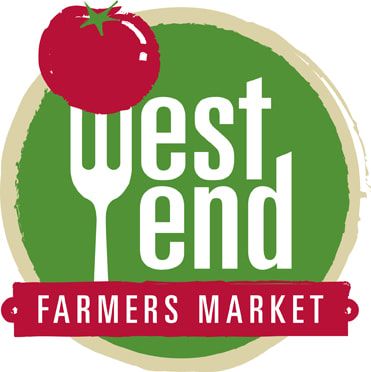
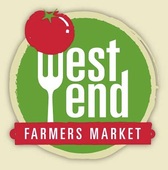
 RSS Feed
RSS Feed
